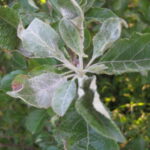Crop loss in 2020 and 2021 led many growers to greatly reducing their fungicide applications, or use just captan or mancozeb, which, although effective against scab, are not effective against powdery mildew. Coupled with our unusually dry weather, this has led to a build-up of powdery mildew (PM) inoculum, and continued management issues surrounding this problem.
Powdery mildew symptoms can range from the subtle (Figure 1) to the incredibly obvious (Figure 2), and everything in between. In Indiana, as in many places, the following cultivars are susceptible: Ginger Gold, Jonathan, Ida Red, Cortland, Baldwin, Granny Smith, and Mutsu (Figure 3). We are starting to see symptoms of PM on Honeycrisp at the farm. Although no one cares about the foliage, PM also infects fruit, and can cause a russetting of the skin that some consumers find objectionable (Figure 4).
Although too late for this year, sprays to control mildew should begin at tight cluster through about fourth cover. One of the most effective fungicides against PM is Rally, if resistance is not an issue but other FRAC 3s to consider for excellent control include Cevya, Topguard, and Indar. The strobilurins (Sovran, Flint) or the 7-11s (Merivon, Pristine, Luna Sensation) are also excellent mildewcides. Many straight SDHIs (Aprovia, Excalia, Fontelis, Miravis and Sercadis) provide fair to very good control of PM—just don’t rotate with a 7-11 fungicide. Finally, sulfur is an old standby—just be careful to not mix with oil, to not apply during hot weather, and scout to make sure you aren’t driving mite flare-ups!
Remember that PM spores can spread and infect new leaves without ANY rain. PM management depends on getting excellent coverage of the entire crop canopy (which means fine droplets—no big honking droplets that splatter and run off the leaf). Using a spreader-sticker will help, but making sure the volume and droplet size provides sufficient coverage by using and checking spray cards is the best way to keep tabs on your application. Keep in mind that wetter locales will want to keep those cover sprays on every 10-14 days.
Cold weather in winter (below -11 degrees F) will kill mildew-infected buds, reducing overwintering inoculum, and may be the only reason to hope for a cold winter!
- Figure 1. Leaf curl is an early symptom of PM in Honeycrisp.
- Figure 2. Later signs of apple powdery mildew include a characteristic white cast to leaves.
- Figure 3. Cultivar differences can be obvious.
- Figure 4. Fruit russet is a symptom of PM.



